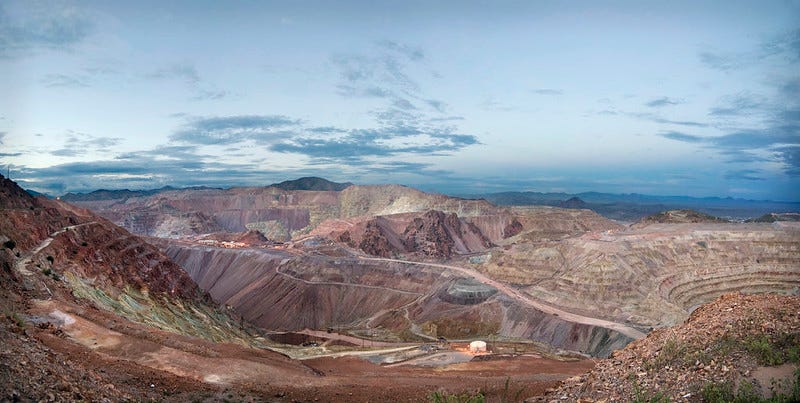When a 'critical metal' is only an afterthought
How does climate action plan to get materials that are only byproducts?
Climate technologies require enormous amounts of metal. I’m Ian Morse, and this is Green Rocks, a newsletter that doesn’t want dirty mining to ruin clean energy.
This summer, the questions and quarrels about the role of mining in climate action matured into three new books. Historian Jay Turner, former journalist Henry Sanderson, and podcast host Paris Marx tackle the topic from unique perspectives. I thought they ought to be in conversation with one another. My review essay for Noema Magazine is linked at the end of this post.
But first, the critical materials that even mining companies are reluctant to extract.
When most media discuss the materials critical to the energy transition, they focus on the big names: lithium, nickel, copper, sometimes a dash of aluminum or a hint of graphite. They can be forgiven for whizzing past indium, gallium, cadmium or tellurium, because mining companies often do as well. These elements are produced as byproducts of mines that aim for metals with bigger markets, like zinc or gold.
Climate infrastructure uses tiny, often irreplaceable flakes of these materials. Indium enables transparent screens to conduct electricity – valuable in consumer electronics and solar cells. Gallium makes electricity shine in LED lights, which have already brought down lighting emissions even as humans produce more light. Cadmium and tellurium combine in the second most common solar cell.
Simon Jowitt, a geologist at the University of Nevada Las Vegas, took this last element, tellurium, as a case study. If climate action demands more tellurium, how are we going to get it? Where is it? How much is even out there?
“It’s a nice case study because it’s a critical element, but it’s a by-product critical element. Nobody really looks for a tellurium deposit,” he says. Tellurium appears in many copper and gold deposits, but more often than not, it ends up in as waste somewhere. It also on critical materials lists in the US and Canada.

In the last edition, we asked how many mines would need to be built to satisfy demand for climate technologies. We can’t do the same with byproduct metals, because we often don’t know where they are. Big-name metals often overshadow the range of possible products in a deposit when a company makes the leap from exploration to operation. Yet those materials remain in the ore that goes through smelting and refining.
“If we’re moving it and mining it already, then surely from a sustainability viewpoint it’s better to extract it than just dump it in a waste pile and have to revisit it later,” Jowitt says.
Jowitt and coauthor Brian McNulty gathered data on 518 mineral deposits known to contain tellurium and analyzed the feasibility of extracting the element from deposits. Mines in the US and Canada process roughly 260 tons of tellurium mixed into their other products but did not extract it. That is almost half of global production of the element. There is likely tens of thousands of tons of tellurium already in waste piles in the US and Canada. He presented the findings at the annual meeting of the Geological Society of America.
“We’ve been mining for millennia, and initially we weren’t interested in these metals. But even when we are interested in these metals — in the last 20-odd years when we’ve been mining more than ever before — we haven’t been recovering them at a decent rate. An awful lot of these materials have ended up in waste piles that are lying there, waiting to be assessed from an economic and potentially environmental value viewpoint.”
Jowitt and McNulty’s method to use proxy mineral and production data to estimate reserves of ‘byproduct critical materials’ can map well onto other materials. Tim Werner, a research fellow at the University of Melbourne, has done similar work on indium, which I wrote about for PV Magazine (paywalled).
When Jowitt speaks with mining companies, some are aware of the potential to reduce waste and boost production of materials related to climate action, but many are not. It takes a fundamental change in operations; to recover the most metal and reduce the impact of operations at each step. It’s not likely that materials that have long been byproducts will become an operation’s main product. But it is possible that companies can reorient business when consumption changes. Rio Tinto says it’s turning “slime into solar panels” with its newly launched tellurium refinery in Utah.
The climate crisis presents both environmental and economic drivers to turn waste into climate technologies. In the US, the federal government may expedite permitting for producing some critical materials, Jowitt says. “It’s important the companies don’t greenwash that they’re producing tellurium from a mine that may be otherwise environmentally problematic. That’s not the endgame we want.”
Reads
≠ endorsement
The mining land rush is on (The Land Desk)
Sulawesi islanders grieve land lost to nickel mine (Mongabay)
How ending mining would change the world (BBC Future)
Shallow-water mining isn’t the eco alternative to deep-sea mining, study says (Mongabay)
Thank you for your patience. Here’s the essay: Who Gave The Battery Such Power?








